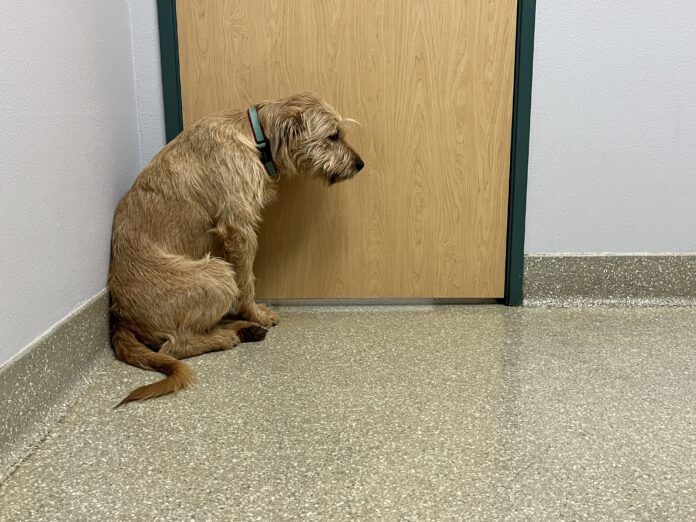The first thing that didn’t seem right when I woke up at around 6 am was that Boone was not asleep on the dog bed that’s in my bedroom. He’s the only one of my dogs who has decided that he would rather sleep near me than on one of the couches or the giant Snoozer dog bed in the living room. But last Thursday morning, he was not in his regular spot.
I got up and went looking to see where he might be – just curious, not worried. He can sleep wherever he wants! I found him curled up on the Snoozer – odd, but not unthinkable. I greeted all three dogs, and opened the front door so they could go outside and pee. But only my two older dogs got up to go outside. Now, that IS weird. Fifteen-month-old Boone is usually jamming his nose in the gap between the door and the frame, cramming his body outside before anyone else. He loves being the first dog outside, so he can joyously race across the lawn, hoping to surprise an unwary squirrel on the ground and make the robins fly. But on this day, he stayed curled up, just looking up at me with his eyes, not even raising his head. “Hey buddy,” I said to him. “What’s up with you?”
I grabbed the dog bowls and headed over to where I keep the dog food. This was the big test, because Boone always – and I mean always – accompanies me to fill the dog bowls. He watches my every move, hovering near the bowls. He doesn’t help himself to the food I measure out, but gets to grab for and scarf up any stray kibbles that hit the ground as I scoop and pour the food into the three bowls. But on this day, he stayed on the dog bed as I prepared the dogs’ meals.
I called Boone over to me. He got up very stiffly, noticeably limping on his right front leg. His head was down. When he stopped walking, he stood in a strange stance, with his right front leg turned at a weird angle. He looked miserable.
I sat on the floor in front of him and did a quick exam. Did he have a cut on his paw, a thorn, a broken toenail? No. Did he have any cuts or scrapes? No. Did he flinch when I pressed and flexed the various joints in his ankle, elbow, or shoulder? Also no. But when I got up and asked him to follow me outside, he moved very stiffly and slowly, not at all like his usual bouncy self. I watched as he urinated – it seemed like the usual color – and then asked him to come back into the house.
I went straight back to my bedroom and got dressed. The closest emergency veterinary hospital is about 30 minutes away and they open at 7 am. If I left right away, we could be there within a few minutes of opening and stand a chance of getting seen before 10 am. I don’t know what was wrong with him, but given that this was on a Thursday before a holiday weekend, I didn’t want to take any chances. As I drove, I thought to myself that I should have taken his temperature before I headed to the vet, but on the other hand, then I wouldn’t be close to first in line at the ER.
My plan paid off; I wasn’t first, but was among the first people there, and they had an opening. We were in a room by 8 am. A technician took his vital signs – and he had a normal temperature. Whew! That ruled some things out. But Boone was definitely not himself. Instead of checking out the room or bugging me for attention and petting, he sat across the room from me, leaning on the wall, head down. When I told him to lie down, he ignored the cue and continued to sit.
When the doctor came in, Boone greeted the doctor in a very low-energy way. The doctor noticed his limp and his strange stance. The doctor also listened to his breathing and heart and palpated his abdomen, but said, “His posture is weird. I wouldn’t be surprised if he hurt his elbow, the way he’s standing. But I’d like to take him in the back and lay him on a table, to rotate and move his shoulder and elbow. And we might need to take some x-rays – but I’ll let you know.”
Within 10 minutes or so, the doctor was back. “Boone didn’t have any trouble with flexing or rotating any joint,” he said. “It’s weird. While it’s possible that he has a hairline fracture or something, I think it’s more likely that he strained or pulled something. I’d like to send him home with some carprofen (an NSAID); let’s see if this resolves in a couple of days of rest – and if it doesn’t, bring him back and we’ll take some x-rays.”
But as the doctor was talking, I was looking at Boone, who was again sitting and leaning against the wall, head down, eyes half-closed. “I feel like there is something else going on!” I said. “This is usually a very energetic 15-month-old dog! Look at his eyes! He’s closing them! He just looks so dopey!”
The vet sort of cut me a look at that last phrase. Until I spontaneously said the word “dopey,” I hadn’t even considered the possibility of Boone having ingested something intoxicating – mostly because neither my husband nor I use any form of cannabis, nor any other type of opiate or medication. I hastily added, “We don’t have any dope on the property! There’s absolutely nothing to get into – no medications, no recreational drugs, nothing!”
“He does seem awfully subdued,” the vet said. He checked the chart, and asked the technician about Boone’s temperature. “It was normal?” he asked. “And you got a good temp, no messing around?” She assured him that she had the thermometer all the way in for the full length of time – that the reading was good.
I asked about various issues that were caused by tick bites (such as tick paralysis) or carried by ticks (such as Lyme disease or anaplasmosis); I had walked Boone and Woody the day before in a particularly tick-infested area. However, I hadn’t let either dog off leash (because we kept spotting deer) and we were walking on a wide dirt road – not many chances to come into contact with the brush or grass that ticks are generally waiting on. And I hadn’t seen any ticks on either Boone or Woody the night before. The doctor said that tick paralysis affects the back legs first – a limp in the front ruled that out. And while a limp could be a sign of a tick-borne disease, a limp that moved from one limb to another (because all the dog’s joints were painful) was more classic – and the dog would most likely have a fever. He said, “It might be helpful to run some blood tests, to see if anything is out of the ordinary. We can check for tick-borne disease, and he’s due for a heartworm test. Let’s get all that, give him the carprofen for a few days, and see where we are after that. But of course, bring him back if he gets worse!” I agreed; maybe the test results would shine some light on this strange, nonspecific malady.

I drove home, and offered Boone the chewable carprofen. I was heartened when he ate it readily, as well as the breakfast that he hadn’t been interested in earlier. But not long after that, he went back to the Snoozer dog bed, and resumed sitting in that weird position, head down, eyes closing. And when I told him to lie down, he again ignored me. He didn’t want to lie down for some reason. We had been home for about 45 minutes when I called the vet again, asking if I could bring Boone back. The receptionist said they could see him again at 12:30. We had to wait 2½ hours – but at least they could see him.
Fortunately, over the next couple of hours, Boone began perking up. When we went out to my office, he went into the big soft crate with the other favorite dog bed in our home, the Wash ’N’ Zip Pet Bed, and lay down, instead of continuing to sit in that strange pose. And when I went to get some coffee from the house, he volunteered to come with me, and it looked like he wasn’t limping as much. Could the carprofen be working that quickly, I wondered? After I got my coffee, I walked around with Boone outside until he went poop; I was relieved to see that it looked normal.
By noon, he was back to sitting in front of my office door looking through the glass like he normally does. I called the veterinary hospital and told them I was sorry for the inconvenience, but that I would not be bringing him back after all; it seemed like he was feeling better.
By that evening, Boone was behaving 100% normally – normal energy, normal appetite, normal gaits (no limp whatsoever). And he’s been fine ever since. What the heck?!
The next day, the vet called to report that all Boone’s blood values were normal, he was heartworm negative, and his tick-borne disease titers were negative.
I’m thrilled that nothing more seems to be wrong with my young dog, but I’m still mystified as to what all that could have been about, and concerned that something is lurking and might resurface. He looked seriously ill for a couple hours – and his limp was not in my imagination; everyone saw it. Did he just have a sprain, and was being the world’s biggest wimp about it? Could he have eaten something intoxicating that someone had thrown over the fence – and the limp was a coincidence? The vet said he didn’t show any signs of discomfort in his gut, but his strange posture and reluctance to lie down made me feel like something was uncomfortable in his tummy. Unless any of these symptoms recur, I’ll never know.







I wish that our dogs (and cats) could talk to us to tell us what’s wrong. Thank goodness your pup is feeling better!
I’m glad for the excellent outcome, and I admire your taking your dog to the vet ASAP. I have three German Shepherd Dogs and, always on a holiday weekend when my regular vet is closed, one of them will need to be seen, so I know the urgent care and emergency care vets in the area. Providing good care to a pet can become very expensive; insurance helps, but when you add up the premiums over the years, the cost of ownership can be high. Still, like with an infant, it’s better to err on the side of caution when dealing with a being who can’t talk and describe their symptoms.
I am so glad it all turned out fine! But what a scary morning you had. Cats, when they are terribly ill with Feline Leukemia, sit exactly the same way. Boone was definitely unhappy and uncomfortable. Well done for taking him to the vet immediately, Nancy! Hopefully, that is it, but I know you will be watching him…
We had the same experience with our ten month old dog. In his case, no limp but he wasn’t able to stand with any stability. Very frightening. Emergency vet ruled out everything. Then she asked if she could run a tox screen because his symptoms were consistent with marijuana intoxication. We said yes, feeling positive that it would be negative because we don’t use drugs or alcohol. Imagine our surprise when he tested positive for marijuana. Where he got it is still a mystery to us, but the vet said that marijuana has a sweet smell and dogs don’t hesitate to eat it if they find it lying around. She surmised that someone had discarded the butt of a marijuana cigarette and Toby found it on one of our regular neighborhood walks. He’s always snuffling around trying to find lizards to chase and could have ingested it without our knowing it. Like Boone, he was fine in 24 hours.
Rena Stevens, Largo, FL
You are not crazy. That poor baby looks absolutely miserable. If he didn’t have a limp I’d say he looks exactly like how I feel when I get a migraine. In any case, I can’t imagine it was a psych thing. The body language just makes me want to do exactly what you did, scoop him up and bring him to the vets. I’m glad to hear he’s feeling better, but it’s unsettling when there is clearly something not right but all tests come back normal.
When my dog acted like that it was dehydration, after some diarrhea and vomit, probably after eating something off.
Our boy having passed a recent medical with flying colours In the September started showing orthopaedic issues in the October with his head hanging low. We took him to the vet who did x-rays expecting to find joint issues. Everything looked good but he got worse and became nauseous in the morning. An MRI scan was done on his neck thinking a spinal issue. The specialist found a tumour and did a brain scan as well where a primary tumour was in situ. Nobody was expecting this. I don’t want to compare his symptoms with Boons but from now on I always look for other alternative to the obvious as this really did catch us off guard.
So Grateful that you shared this with us. I’ve had this happen with more than one dog. Sometimes, it turned out bad, others not. Please keep us up to date. Everything with our pets is a constant education. .
Nancy, I know this can sound a little weird, but you might try an animal communicator. I use one here in Colorado and although I don’t agree or do not ALL she tells me or recommends, she seems right more often than not. We just got a new puppy with our 7-year-old Border Collie who is a people dog and ignores MOST dogs and other animals except bunnies, squirrels and the cats at the barn where we board our horses. We were concerned about what would happen with the two and most of what she told us happens to be correct so far! Boone looks and sounds like a great dog and I hope he was just a bit off that day! Good luck And Thanks for All the Great Stories!
Our previous dog, now passed on, was always spunky and eager to eat when she got up in the morning. One day when she was about 11 years old, she showed no interest in breakfast or a walk, and curled up looking dejected in her dog bed near the kitchen. I knew if this dog wouldn’t eat something was off. I called the vet and with nothing more specific to tell them, they said keep an eye on her and call back if I felt she needed to come in. She stayed in her dog bed for hours, squinting and looking sleepy. I called during the afternoon to get her worked in later in the day. When we went in to be seen, she was very docile and not her usual rather nervous and defensive self at the vet. The vet started with all the usual blood work and exams, normal of course, and the only thing she kept noting was the squinting. Leah was showing hypersensitivity to light; when the vet darkened the room, she visibly relaxed. It occurred to the vet to measure her eye pressure, and glaucoma was diagnosed then and there. It was mild and not yet advanced, and eye drops controlled it for the rest of her life. Training her to accept the drops twice a day was a project though!